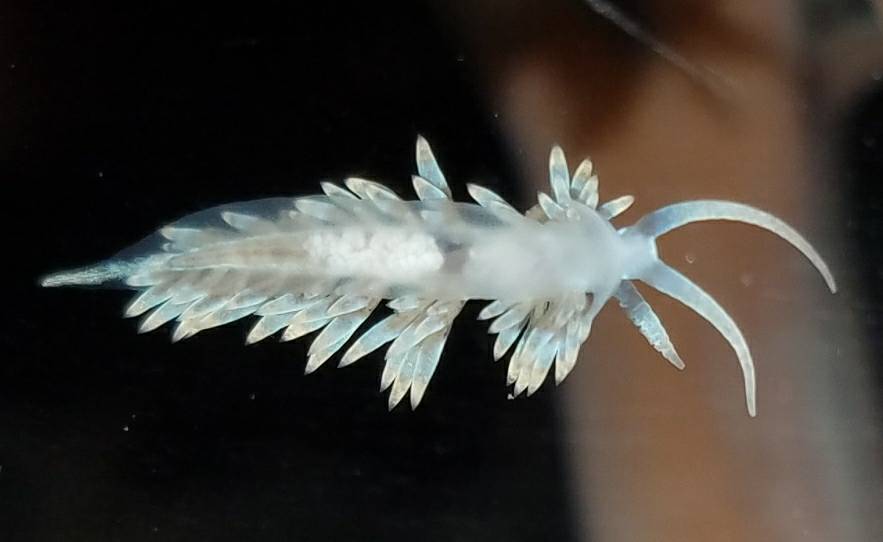Aiptasia anemones are a common nuisance in reef aquariums, known for their rapid reproduction and potential to cause harm to corals and other invertebrates. Effectively controlling and eliminating Aiptasia populations is crucial for maintaining a healthy and thriving reef ecosystem. In this article, we will how to get rid of Aiptasia anemones, including natural solutions like Berghia nudibranchs and other predators, manual removal, and chemical treatments.
Natural Solutions for Aiptasia Control:

Full Berghia Nudibranch Guide Click Here
- Berghia Nudibranchs (Berghia stephanieae): Berghia nudibranchs are small sea slugs that feed exclusively on Aiptasia anemones. They are considered reef safe and will not harm corals or other invertebrates in your aquarium. By introducing Berghia nudibranchs to your tank, you can effectively eliminate Aiptasia populations naturally.
- Peppermint Shrimp (Lysmata wurdemanni): These small, colorful shrimp are known for their appetite for Aiptasia anemones. However, they may also consume other types of anemones and polyps, so it’s essential to consider their compatibility with your specific reef setup.
You May Also Like: Peppermint Shrimp: The Colorful Aiptasia Assassin
- Copperband Butterflyfish (Chelmon rostratus): Copperband butterflyfish are known for their ability to consume Aiptasia anemones, but they may also prey on other invertebrates, such as coral polyps and feather dusters. These fish can be challenging to keep, as they have specific dietary requirements and may be sensitive to water quality changes.

Related: Berghia Nudibranch vs. Aiptasia Eating Peppermint Shrimp (Ultimate Guide)
Manual Removal of Aiptasia Anemones:
In cases of small Aiptasia populations, manual removal can be an effective method. Use a syringe or pipette to inject boiling water, lemon juice, or a commercially available Aiptasia treatment directly into the anemone, causing it to retract and die.
Be cautious not to harm other organisms during this process. It is important to note that manual removal can be time-consuming and may not be suitable for large infestations.
Chemical Treatments for Aiptasia Control:
Several chemical treatments are available for controlling Aiptasia anemones. These products typically contain calcium hydroxide, potassium hydroxide, or other chemicals that cause the anemones to retract and die upon contact.
Follow the manufacturer’s instructions carefully and ensure that you do not harm other organisms in your tank during the treatment process.
Keep in mind that chemical treatments can be harsh and may affect your water quality, so it is essential to monitor your water parameters closely during and after treatment.
Check out Aiptasia-X. One of our favorite chemical treatments.
Preventing Aiptasia Infestations:
To prevent the introduction of Aiptasia anemones into your reef aquarium, consider the following measures:
- Quarantine new additions: Quarantine new corals, live rock, and other invertebrates before adding them to your main tank. This will help to prevent the introduction of Aiptasia and other pests.
- Inspect new live rock and corals: Carefully inspect new live rock and corals for the presence of Aiptasia anemones before introducing them to your tank. Remove any Aiptasia you find by using manual removal techniques or by dipping the live rock or coral in a coral dip solution.
- Maintain water quality: A stable and well-maintained reef environment can help to discourage the growth of Aiptasia and other nuisance organisms. Perform regular water tests and maintain appropriate water parameters, including salinity, pH, and temperature.
Check out are article on Aiptasia Eating Filefish: The Ultimate Solution for Aiptasia Control
How To get rid of Aiptasia anemones: Final Thoughts

Eliminating Aiptasia anemones from your reef aquarium can be challenging, but with a combination of natural solutions, manual removal, and chemical treatments, it is possible to control and eradicate these nuisance organisms.
By incorporating effective strategies and maintaining a healthy, well-balanced reef environment, you can prevent Aiptasia infestations and protect your corals and invertebrates.
To learn more about natural Aiptasia control methods, check out this article on Berghia nudibranchs. For additional information on maintaining a healthy reef aquarium, read our comprehensive guide on Bio S Nitrifying Bacteria.
FAQ:
Q: What are Aiptasia anemones? A: Aiptasia anemones are small, brownish or translucent anemones that can quickly establish themselves in reef aquariums. They are considered a nuisance due to their rapid reproduction and potential to harm corals and other invertebrates.
Q: Are Berghia nudibranchs reef safe? A: Yes, Berghia nudibranchs are considered reef safe, as they do not harm corals or other invertebrates in your aquarium. They feed exclusively on Aiptasia anemones, making them an excellent natural solution for Aiptasia control.
Q: Can I manually remove Aiptasia anemones? A: Yes, manual removal can be an effective method for small Aiptasia populations. Inject boiling water, lemon juice, or a commercially available Aiptasia treatment directly into the anemone, causing it to retract and die. Be cautious not to harm other organisms during this process.
Q: Are chemical treatments safe for my reef aquarium? A: Chemical treatments can be effective in controlling Aiptasia anemones, but they may also affect your water quality and potentially harm other organisms in your tank. Always follow the manufacturer’s instructions carefully and monitor your water parameters closely during and after treatment.
Q: How can I prevent Aiptasia infestations in my reef aquarium? A: To prevent Aiptasia infestations, quarantine new additions, inspect new live rock and corals, and maintain water quality. Additionally, consider introducing natural Aiptasia predators, like Berghia nudibranchs, to help control their population.



